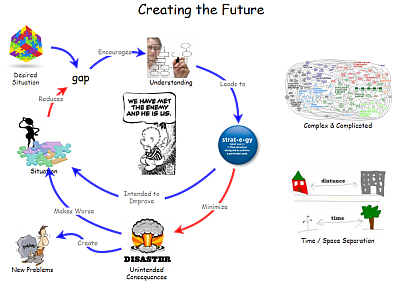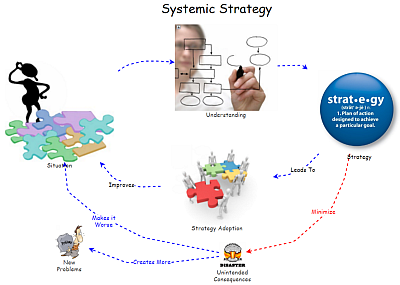
Applied Understanding: Systemic Strategy [Systems thinking & modelling series]
This is part 17 of a series of articles featuring the book Beyond Connecting the Dots, Modeling for Meaningful Results.
The Applied Understanding section presents a number of models, offered primarily by Beyond Connecting the Dots sponsors, in different subjects areas. These models are designed to be more directly related to real situations than those in prior sections.
At this point, if you are enjoying this article series we ask that you consider taking a moment to share it with your friends and colleagues.
Systemic Strategy
As we think about the problems we face today it is readily evident that most of these are the direct result of yesterday’s solutions. To enable a better tomorrow we must develop a viable approach for dealing with situations. We need an approach that addresses the situation while minimizing the likelihood of making the situation worse or creating new problems that will have to be addressed in the future. The foundation of this approach, as with all real progress, is learning. The next two models present a basis for the requisite learning.
Background
Numerous new approaches to problem solving have been developed and promoted over the years. Some of these became fads and were readily adopted by many. But the fads were not well founded and in time proved not to deliver the expected results. When the expected results were not delivered, the fads were discarded in favor of the next fad. As Michael McGill points out1, the real difficulty lies in a flawed mental model under which both the promoters and the adopters operate. That flawed mental model is their belief that there can be a quick fix.
In contrast, well grounded and proven approaches to problem solving have not been widely adopted. Those with flawed mental models consider the proven approaches to be too complicated or time consuming. The quest for the ever elusive quick fix condemns us to endlessly solving the new problems created by the prior quick fixes. This is the type of result expected from operating with flawed mental models2. We must realize the quick fix is a myth and invest the time to learn proven methods and create sound solutions.
Creating the Future
Whether we’re considering a problem, a situation, an objective, or a desire, the underlying essence of the manner in which we deal with the situation is as presented in the following “Creating the Future” model.
The intent is to solve problems without creating new ones.
Need help? See the Model instructions
Whether we realize it or not, this model can be applied to just about everything that happens in our lives. Even when we don’t consciously think about it, the interactions depicted are operating. The extent to which people consciously think about these relations varies. Some people think about the implication of their actions and stop there. And some people think about the implications of implications of implications. They do this because they understand that things are highly interconnected and the implications are generally not obvious and often difficult to foresee.
Systemic Strategy
Realizing that there is an underlying set of interactions as depicted in the “Creating the Future” model, which is essentially the foundation of all our endeavors, it seems sensible to seek a deeper awareness of how we develop the requisite understanding. An introduction to developing this understanding is depicted in the “Systemic Strategy” model.
Relevant pieces of the puzzle for real progress.
Need help? See the Model instructions
“Systemic Strategy” represents an iterative unfolding of understanding. This understanding forms the basis for developing a strategy which, when implemented, is highly likely to address the situation of interest as intended. At the same time, the strategy minimizes the likelihood of unintended consequences or creating new problems. There is another Interactive Learning Environment in the works based on this model, titled “Enabling a Better Tomorrow.”
Next edition: Applied Understanding: Victims of the System or Systems of the Victim.
Article sources: Beyond Connecting the Dots, Insight Maker. Reproduced by permission.
Header image source: Beyond Connecting the Dots.
References:





